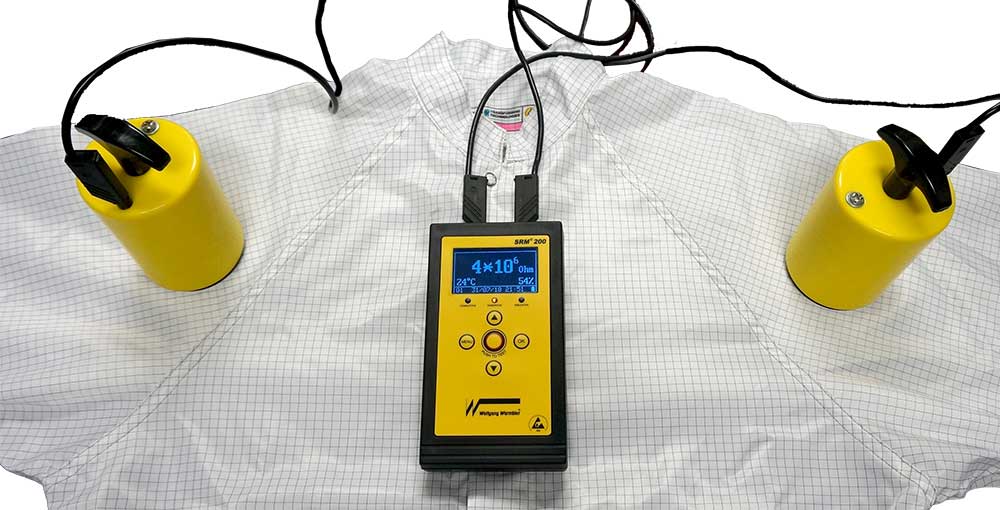How ESD Jackets Work
 How ESD Jackets Work
How ESD Jackets Work
ESD jackets, also commonly known as ESD smocks, ESD lab coats or ESD garments, offer protection from electrostatic fields generated by clothing on the user’s body. ESD jackets are worn where ever static damage is a concern primarily in electronics manufacturing, semiconductor and other industries concerned with ESD Damage. ESD jackets are the most visible sign of ESD protection and any facility that mandates ESD garments demonstrates a commitment ESD protection.
 ESD jackets are a recommended addition to a program that already includes typical grounding measures, such as wrist straps and heel grounders. This is because of the potential hazard of the operator’s clothing. The ESD TR20.20-20 states: “While a person may be grounded using a wrist strap or other grounding methods, that does not mean that insulative clothing fabrics can dissipate a charge to that person’s skin and then to ground. Personnel clothing usually is electrically separate or isolated from the body.”
ESD jackets are a recommended addition to a program that already includes typical grounding measures, such as wrist straps and heel grounders. This is because of the potential hazard of the operator’s clothing. The ESD TR20.20-20 states: “While a person may be grounded using a wrist strap or other grounding methods, that does not mean that insulative clothing fabrics can dissipate a charge to that person’s skin and then to ground. Personnel clothing usually is electrically separate or isolated from the body.”
 ESD jackets are typically made from a polyester, cotton or blend of those fabrics in many colors with blue being most common. ESD jackets differ from common work garments because they contain a grid of conductive fibers imbedded throughout the garment. ESD Jackets work by creating a “Faraday Cage” effect around the body of the operator, that shields static charges generated from the operator’s clothing that could damage devices that are sensitive to static electricity. ESD jackets can have a lapel collar or v-neck with sleeve terminations of a snap cuff or ESD knit cuff. ESD jacket cuffs are explained here.
ESD jackets are typically made from a polyester, cotton or blend of those fabrics in many colors with blue being most common. ESD jackets differ from common work garments because they contain a grid of conductive fibers imbedded throughout the garment. ESD Jackets work by creating a “Faraday Cage” effect around the body of the operator, that shields static charges generated from the operator’s clothing that could damage devices that are sensitive to static electricity. ESD jackets can have a lapel collar or v-neck with sleeve terminations of a snap cuff or ESD knit cuff. ESD jacket cuffs are explained here.
 Three are three levels of ESD jackets according to ANSI ESD S20.20 standards. At minimum, a ESD jacket must test as dissipative (surface resistivity of < 1 x 10^11 ohms resistance). If the fabric of ESD clothing is conductive enough, it can also be used as a groundable static control garment. This means the wearer can be grounded through their ESD clothing. To be considered a groundable static control garment, the garment must have reliable panel-to-panel or sleeve-to-sleeve continuity – meaning electricity can flow freely across the clothing and safety dissipated to ground. If it does not have continuity, a section of the garment may become an isolated conductor, hold a charge and potentially cause an ESD event. ESD Jackets are tested with a Surface Resistance Meter or a Personal Ground Tester and we explain the ANSI ESD Standards test here.
Three are three levels of ESD jackets according to ANSI ESD S20.20 standards. At minimum, a ESD jacket must test as dissipative (surface resistivity of < 1 x 10^11 ohms resistance). If the fabric of ESD clothing is conductive enough, it can also be used as a groundable static control garment. This means the wearer can be grounded through their ESD clothing. To be considered a groundable static control garment, the garment must have reliable panel-to-panel or sleeve-to-sleeve continuity – meaning electricity can flow freely across the clothing and safety dissipated to ground. If it does not have continuity, a section of the garment may become an isolated conductor, hold a charge and potentially cause an ESD event. ESD Jackets are tested with a Surface Resistance Meter or a Personal Ground Tester and we explain the ANSI ESD Standards test here.
Transforming Technologies Supplies Five Types of ESD Jackets in many shapes and sizes. View our full line of ESD jackets here.
Contact us at 419-841-9552 today to learn more!
